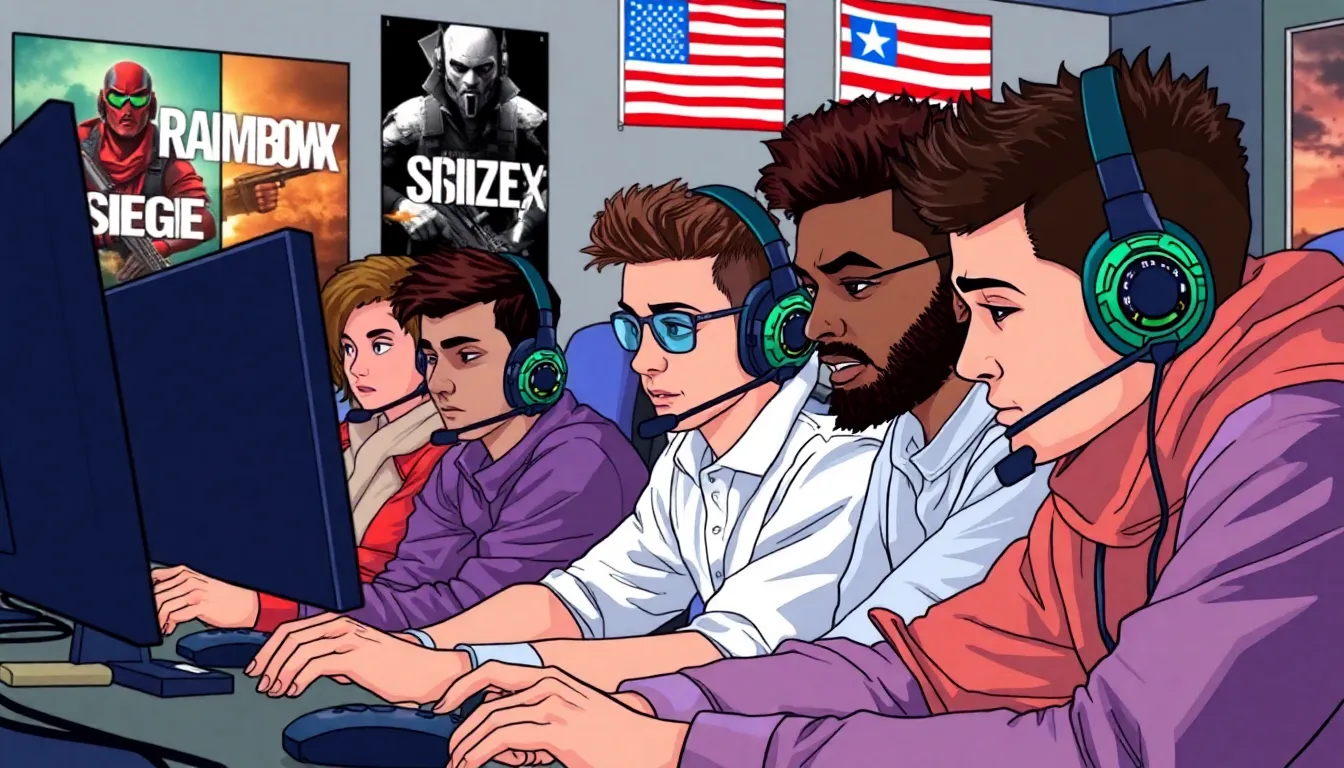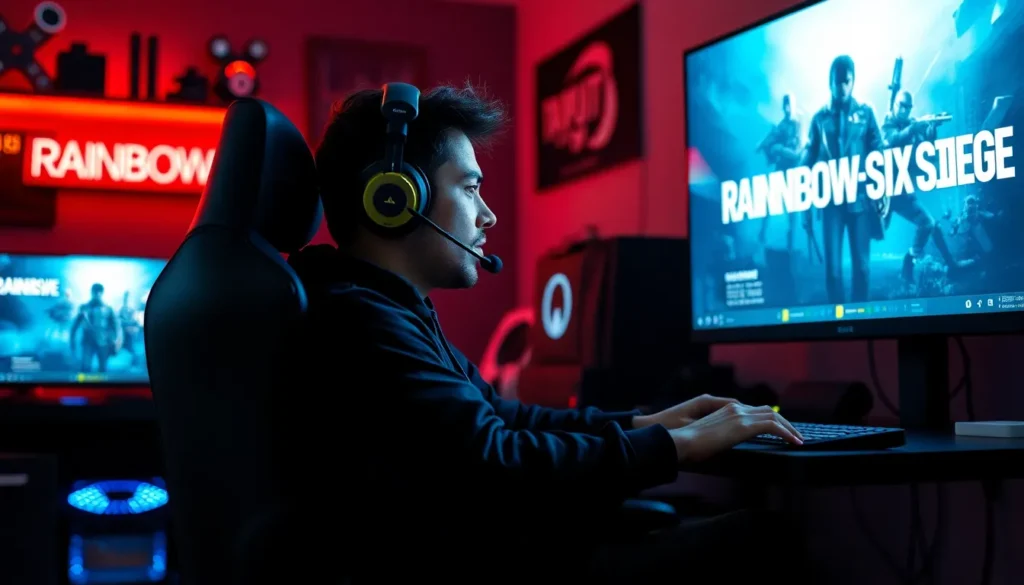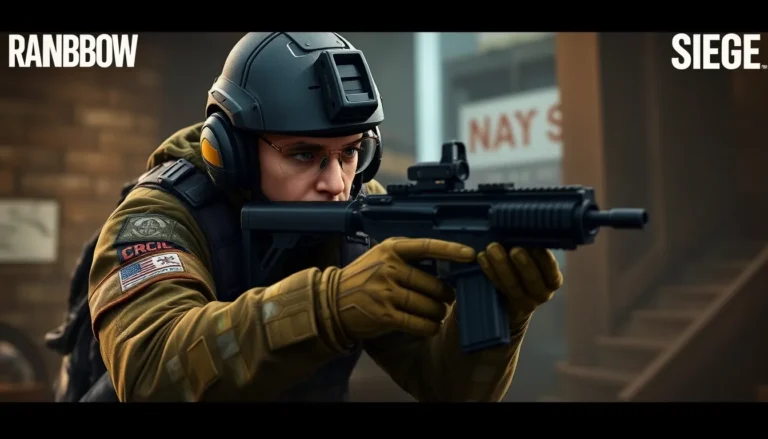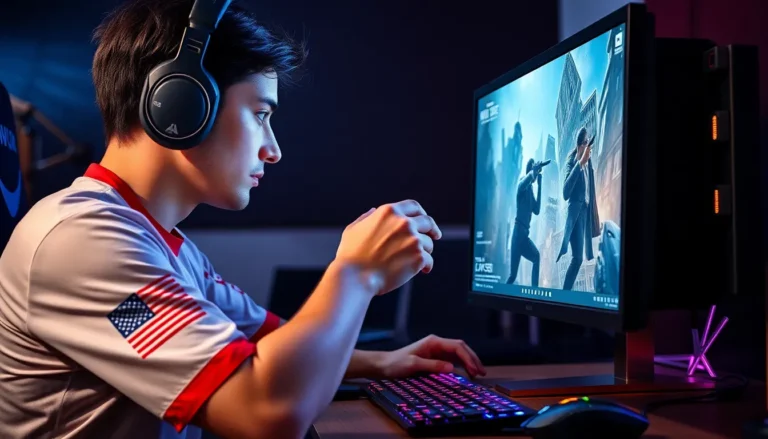Table of Contents
ToggleIn the world of tactical shooters, few games create as much excitement and tension as Rainbow Six Siege. Players dive into a battlefield of strategy and skill, but nothing quite tests their mettle like the ranking system. It’s not just about winning; it’s about climbing the ranks and proving you’re more than just a casual player.
Imagine the thrill of seeing your rank rise as you outsmart opponents with your clever tactics. But beware—the journey isn’t for the faint-hearted. With each match, players face the exhilarating highs of victory and the gut-wrenching lows of defeat. Understanding the ranking system is crucial for anyone looking to elevate their game and maybe even earn some bragging rights among friends. So, buckle up as we explore the ins and outs of this competitive ladder, where every match could mean the difference between glory and despair.
Overview Of Rainbow Six Siege Ranking System
The ranking system in Rainbow Six Siege categorizes players based on performance in competitive matches. Players receive a skill rank, represented as a letter grade and a numeric value, where the letter denotes the league and the number indicates the player’s skill within that league.
Ranks and Leagues
The ranking system consists of various ranks:
- Copper: Ranks from Copper I to Copper IV, reserved for beginner players.
- Bronze: Ranks from Bronze I to Bronze IV, representing players with fundamental understanding of the game.
- Silver: Ranks from Silver I to Silver IV, showcasing average players skilled in tactics and objectives.
- Gold: Ranks from Gold I to Gold IV, indicating above-average players with refined skills.
- Platinum: Ranks from Platinum I to Platinum IV, representing highly skilled players known for strategic gameplay.
- Diamond: Ranks from Diamond I to Diamond IV, reserved for top-tier players with exceptional tactics.
- Champions: The final rank, as it includes the highest-performing players globally, forming the elite.
Matchmaking and Skill Rating
Players’ skill ratings adjust after each match based on performance metrics, including kills, deaths, and objective play. Winning ranked matches increases skill ratings while losing decreases them. Furthermore, the match’s competitive balance pairs players of similar skill levels, ensuring fair and engaging gameplay.
Ranking Placement
At the beginning of each season, players undergo placement matches to determine their initial rank. Completing ten placement matches influences the starting rank prominently. Rank decay occurs for inactive players, compelling regular play to maintain or enhance ranking.
Understanding the intricacies of the ranking system not only sets expectations for progression but also aids in improving strategies and maximizing performance in Rainbow Six Siege’s competitive landscape.
Ranks And Tiers

Rainbow Six Siege features a detailed ranking system that categorizes player performance, impacting competitive play significantly.
The Different Ranks Explained
Ranks in Rainbow Six Siege vary from Copper to Champion. Players start at Copper, which represents beginners, and progress through Bronze, Silver, Gold, Platinum, and Diamond before reaching Champion, reserved for the top 1% globally. Each rank consists of four divisions except for Champion, which has no divisions. Players earn ranks based on their match performance, winning games increases rank, while losses result in a decrease. These ranks serve as a benchmark for skill level, helping players gauge their improvement and understanding of the game.
How Tiers Impact Gameplay
Tiers greatly influence gameplay dynamics in Rainbow Six Siege. Each tier within a rank represents a range of skill levels, affecting matchmaking algorithms. Players within the same tier encounter similarly skilled opponents, ensuring balanced and competitive matches. Higher tiers introduce more advanced strategies and coordination demands, pushing players to adapt and enhance their teamwork. Additionally, achieving higher tiers unlocks exclusive cosmetic rewards and recognition among the community, motivating players to strive for continuous improvement and mastery of the game.
Matchmaking Process
The matchmaking process in Rainbow Six Siege is crucial for maintaining fair and competitive gameplay. Players are paired with others of similar skill levels, ensuring evenly matched matches that emphasize tactical gameplay.
Understanding MMR
MMR, or Matchmaking Rating, quantifies a player’s skill level based on performance metrics. Players start with a default MMR at the beginning of each season, influenced by their placement match results. Winning increases MMR, while losses decrease it. MMR adjustments occur after each match, promoting a dynamic environment that encourages continuous improvement. Players can track their MMR through their profile, providing insight into their progression through the ranks.
Factors Affecting Matchmaking
Multiple factors influence the matchmaking process in Rainbow Six Siege. These include player skill, connection stability, team composition, and geographic location. Skill ratings help the system create balanced teams, while connection stability ensures smooth gameplay. The algorithm also considers current matchmaking queues to mitigate long wait times. Matching players from similar geographic regions minimizes latency and promotes a better gaming experience. Understanding these factors highlights the complexities involved in achieving fair and competitive matches.
Tips For Improving Your Rank
Improving rank in Rainbow Six Siege requires focused strategies and teamwork. Here are key areas to concentrate on.
Playing As A Team
Collaborating with teammates increases the chances of winning rounds. Communication remains essential; players must call out enemy locations, coordinate strategies, and share information about objectives. Establishing a pre-game plan streamlines execution during matches. Roles should be clearly defined, assigning attackers and defenders based on player strengths. Regular player swaps among friends can enhance familiarity and synergy, improving overall teamwork. Players who prioritize team efforts over individual success tend to achieve higher ranks.
Strategic Operator Selection
Choosing the right operators significantly impacts match outcomes. Players should consider the team’s overall composition and adapt to map requirements. Utilizing a balanced team of attackers and defenders fosters stronger strategic positioning. Diversity in operator abilities offers flexibility during conflicts, with each operator contributing unique strengths. Players must analyze opponents’ operator selections and adjust accordingly to exploit weaknesses. Experimenting with different operators in casual matches enhances familiarity before ranked play, aiding in quick adaption under pressure. Strategic operator selection equates to increased synergy and more effective gameplay.
Common Misconceptions
Misconceptions about the Rainbow Six Siege ranking system can hinder players’ understanding and progress.
- Winning means immediate rank progression
Winning a match doesn’t guarantee rank advancement. Rank increases depend on a player’s overall performance metrics, including kills, deaths, and objective completions.
- Lower ranks signify lack of skill
Lower ranks reflect new players still learning game mechanics and strategies. Many experienced players intentionally rank down to play with friends or experiment with different strategies.
- Matchmaking rewards consistent wins
Matchmaking adjusts MMR and ranks based on multiple factors, including teamwork dynamics and solo or squad performance. Winning streaks can boost ranks, but individual contributions matter significantly.
- Seasoned players remain at the same rank
Players frequently experience rank changes throughout seasons based on performance. Rank decay occurs for inactive players, requiring consistent gameplay to maintain and improve rank.
- Ranking is solely based on wins and losses
Although wins and losses influence ranks, players’ overall match performance plays a critical role. Metrics such as kills, assists, and objective completion rates also impact rankings.
- All ranks are created equal
Each rank tier offers unique challenges and gameplay dynamics. Higher ranks introduce more skilled opponents and better teamwork expectations, necessitating improved strategies and coordination.
- It’s impossible to change ranks
Players can change ranks through continuous improvement, learning from mistakes, and adapting strategies. Engaging in practice and collaborating with teammates fosters growth and rank advancement.
Understanding these misconceptions helps players navigate the ranking system more effectively, optimize performance, and enhance their experience in Rainbow Six Siege.
The ranking system in Rainbow Six Siege is a vital aspect of the game that shapes players’ experiences. By understanding the nuances of ranks and matchmaking mechanics, players can better navigate their journey through the competitive landscape.
Emphasizing teamwork and strategic gameplay is essential for climbing the ranks. As players improve their skills and adapt their strategies, they not only enhance their own performance but also contribute to their team’s success.
With dedication and a focus on collaboration, players can achieve higher ranks and gain recognition within the community. The journey may be challenging but it’s also rewarding for those willing to invest time and effort into mastering the game.







